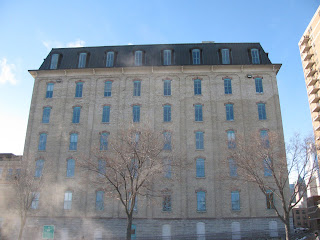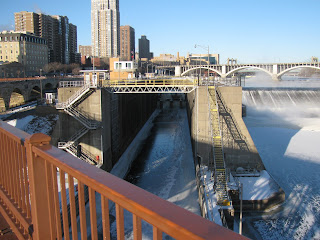Background
The Mississippi River was the main highway for travel to the Midwest and it's sister river, the Missouri, was the main highway west into the territory of Dakota and Oregon country. But eventually came steam power to the U.S. and soon enough, trains were hauling passengers to places away from the rivers. The Mississippi and Missouri Rivers were still major freight haulers, with a single ship being able to haul thousands of tons of rock, lumber, freight, and lastly, flour.The flour mill industry was tied not to the railroads, at least not initially, but rather bound by the great waters that flowed through the central states. This is where towns like Minneapolis and St.Paul got their start. The climate in Minnesota is perfect for growing grains, and those grains are milled into flour at the large industries that sprouted up in Minneapolis and St. Paul. But why is Minneapolis where it is? Why didn't the people just build somewhere else, out of the river valley, and into the great plains on top?
The reason for having the Twin Cities where they are was because this is one of the fall lines of the Mississippi River. The flour mills needed cascading water to power turbines, which in turn ground the flour in the mill. And the Famous St. Anthony Falls provided that cascade. This is also as far north as barges could go because an adequate lock system couldn't be built big enough and strong enough for the boats at this section of the river.
I could write on and on about the River, however that is all we railroaders really need to know. So now let's focus on the Railroads around the Twin Cities.
Just before the turn of the 20th century, trains were finally able to out pull, and out pace a boat. On top of this, near by cities like Chicago and Milwaukee needed grains and flour, so the mills adapted to this by going towards steam trains rather than by boat. Northern Pacific, Minneapolis St. Paul and Sault Ste. Marie (SOO Line), Burlington Route, Milwaukee Road, and late in the game, the CNW. Also Canadian Pacific and Canadian National all had routes going through the cities, plus many more. So the trains came to pick up the flour and grains, then shipped it off to far away places.
Flour Mill Operations
Modelers are probably most interested in how the flour mills milled and dropped the grain into trains. What is more amazing is that this was done. Specifically, modelers want to focus on the loading and unloading operations. Below is a diagram describing the operations:
The steps are as follows:
Step 1. Grain is unloaded from box cars into large grain bins. Before WWII, most grain was shipped through box cars sealed with sheets of wood and paper to make a large covered container for the grain. In modern day, we have the covered hopper to ship grains, cement, and a variety of other products that are in a pellet or grain form.
Step 2. The bins are unloaded by having a conveyor with buckets or scoops take out a load of grain and raise the grain up to the processing level. Normally, grain was dried at the elevator, however this process could be seen at the mills too.
Step 3. The grain is processed, cleansed, then ground into flour. the flour could be whitened, it could also remain whole wheat and be of that cream color.
Step 4. The flour is bagged and then boxed in crates. the flour would then be shipped all over the country, and even the world.
While modeling a mill complex, a large mill tended to have a multiple track yard with tracks going to the unloading and loading areas of the complex. In the case of Minneapolis, the unloading was nearest the river, while the loading was behind the building, closer to the yard. Multiple mills would also share the same yard if close together. Smaller mills would be located away from the urban center and more towards the outside of town, but still along a river if possible. These mills typically had a two-four track yard with a spur for unloading and a spur for loading. Real small complexes may have just had a spur for the loading/unloading. Cars would be put into the yard on a certain track where they wait to be put into the unloading track. Cars would also be put in the yard to be placed on the loading track later on. Cars would then be assembled full of loaded flour, and put behind and outbound engine. A typical yard set up for a large mill would look like below:
That is an overview about the operation of grain mills.
Modeling Mills
For the most part, modeling a Flour mill is just like a grain elevator, but on a large scale. In real life, all the elevators in the region that sell to a particular flour mill ship the grain to the mill via trains. This is true even by today's standards in some areas of the U.S. and Canada. Unlike an elevator, grain is unloaded from the cars and is taken out in bags by either truck or by train. Grain elevators take grain from field trucks and load it into railcars, with the exception of regional elevators that rely on the railroad to bring in grains instead of trucks. The operations between elevators and mills are simply reversed.
Depending on the size of the mill, a set of yard track may be necessary. A good rule of thumb would be to have enough trackage in the yard to store just as many cars as the loading and unloading tracks can hold. So if the mill holds ten cars, then a yard should be at least a ten car yard. The mill itself is a large structure usually, so be prepared to need some space on the railroad layout surface.
Prototypes
Prototype mills are few and far between in modern day,however they still exist in large cities in the Midwest. However, around the turn of the 20th century, mills were everywhere in the Midwest between Detroit and Minneapolis/St.Paul. I was fortunate enough to have visited the mill district of Minneapolis by St. Anthony falls during Christmas, so I have many photos of the area.
The River and bridges:
In the Fore Ground you can see the Old Stone Bridge. 2 spans have been replaced with a steel truss in order to allow ships into the locks by St. Anthony Falls.
Pieces of Railroad history still remain at the river. Here you can see a stone pier for a truss bridge that used to cross the Mississippi down stream from the Old Stone Bridge.
Here are views of the Central Avenue Bridge. This bridge spans the St. Anthony Falls. St. Anthony falls was at one time very high and similar to Niagara, however the soft rocks underneath the waters allowed the falls to rapidly disappear Urbanization also contributed to this, and so in an effort to keep the waters falling, and the mills in business, the falls were encased in cement. This slowed the erosion to almost nothing and now the falls stand proud as a steep slope of cement.
The Mills
Vegas has the waving cowboy, Rapid City has the stock grower on horseback, New York has I Love New York, and Minneapolis has Gold Medal Flour. This sign is very famous in Minneapolis and belonged to the Gold Medal Flour mill along the river. This particular sign was preserved along with much of the rest of the structure as a museum about milling history.
This is a Mill Stone, and the monument was made so that all visitors to the area remember how grain was milled in this area for many years.
This was once the Crown Roller Mill, but now sits as a large office building.
This would have been the power plant generator for the mill in later years as the mill became powered by coal.
Flour mills weren't the only mills in Minneapolis. Here is the North Star Blankets textile mill.
Another sign tells what mill it is. Here is the Pillsbury Mill.
Standing on the Old Stone Arch Bridge, looking South you can see the Washburn A. Mill.
Looking across the river you can see the Pillsbury Mill.
This is the unloading area for grain. The trusses supported the tracks above the spillway, and the cars would be unloaded here, and dumped into the large bins for storing grain.


























No comments:
Post a Comment